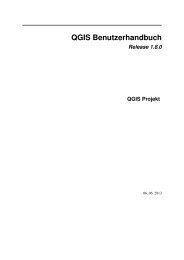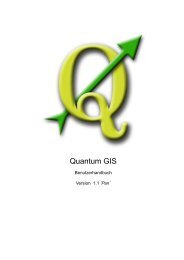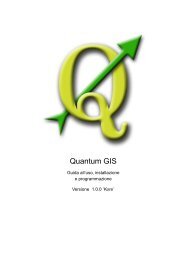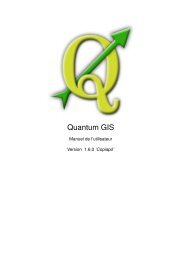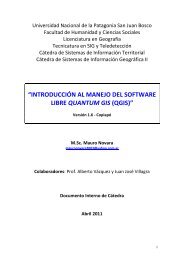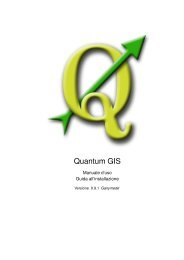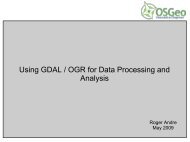QGIS User Guide - OSGeo Download Server
QGIS User Guide - OSGeo Download Server
QGIS User Guide - OSGeo Download Server
Create successful ePaper yourself
Turn your PDF publications into a flip-book with our unique Google optimized e-Paper software.
12 USO DEI PLUGIN CORE <strong>QGIS</strong><br />
12.5. eVis Plugin<br />
The Biodiversity Informatics Facility at the American Museum of Natural History’s (AMNH) Center for<br />
Biodiversity and Conservation (CBC) 9 has developed the Event Visualization Tool (eVis), another<br />
software tool to add to the suite of conservation monitoring and decision support tools for guiding<br />
protected area and landscape planning. This plugin enables users to easily link geocoded (i.e.,<br />
referenced with latitude and longitude or X and Y coordinates) photographs, and other supporting<br />
documents, to vector data in <strong>QGIS</strong>.<br />
eVis is now automatically installed and enabled in new versions of <strong>QGIS</strong>, and as with all plugins, it<br />
can be disabled and enabled using the Plugin Manager (See Section 11.1).<br />
The eVis plugin is made up of three modules: the Database Connection tool, Event ID tool, and the<br />
Event Browser. These work together to allow viewing of geocoded photographs and other documents<br />
that are linked to features stored in vector files, databases, or spreadsheets.<br />
12.5.1. Event Browser<br />
The Event Browser module provides the functionality to display geocoded photographs that are linked<br />
to vector features displayed in the <strong>QGIS</strong> map window. Point data, for example, can be from a<br />
vector file that can be input using <strong>QGIS</strong> or it can be from the result of a database query. The vector<br />
feature must have attribute information associated with it to describe the location and name of the file<br />
containing the photograph and, optionally, the compass direction the camera was pointed when the<br />
image was acquired. Your vector layer must be loaded into <strong>QGIS</strong> before running the Event Browser.<br />
Launch the Event Browser module<br />
To launch the Event browser module either click on the Event Browser icon or click on<br />
Plugins > eVis > eVis Event Browser . This will open the Generic Event Browser window.<br />
The Generic Event Browser window has three tabs displayed at the top of the window. The Display<br />
tab is used to view the photograph and its associated attribute data. The Options tab provides<br />
a number of settings that can be adjusted to control the behavior of the eVis plugin. Lastly, the<br />
Configure External Applications tab is used to maintain a table of file extensions and their associated<br />
application to allow eVis to display documents other than images.<br />
9 This section is derived from Horning, N., K. Koy, P. Ersts. 2009. eVis (v1.1.0) <strong>User</strong>’s <strong>Guide</strong>. American Museum of<br />
Natural History, Center for Biodiversity and Conservation. Available from http://biodiversityinformatics.amnh.org/,<br />
and released under the GNU FDL.<br />
<strong>QGIS</strong> 1.4.0 <strong>User</strong> <strong>Guide</strong> 146



